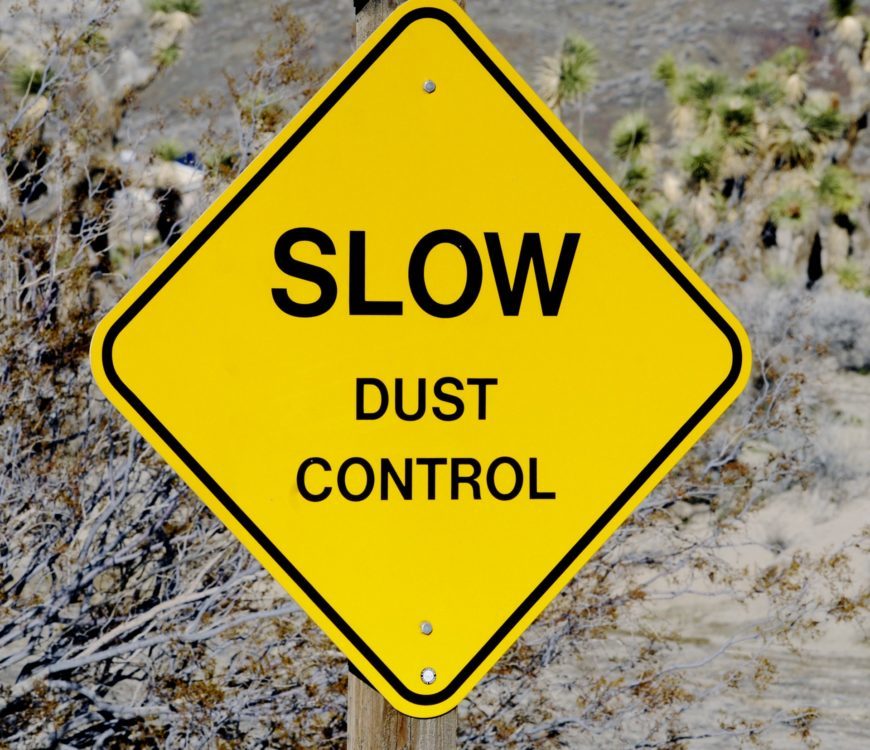
While working in an outdoor environment during field activities such as excavation, filling , drilling, or other earthwork activities, dusts may be generated that can pose a risk to the health of on-site workers and to the general population near the job site. These “nuisance dusts” also can be generated from vehicles driving over unpaved surfaces on the job site. The toxicity of nuisance dusts may vary depending on the composition of the source material(s), and could present a hazard to the health of on-site workers and the local population. Inhalation of these dusts can cause irritation of the lungs, eyes, nose, and throat, and chronic exposure could lead to bronchial asthma, emphysema, and bronchitis. If sufficient amounts are inhaled, nuisance dust may elicit some tissue response in the lungs.
The Occupational Safety and Health Administration (OSHA) currently uses the term “particulates not otherwise regulated” to refer to nuisance dusts that are not specifically linked to health effects other than physical irritation. Conversely, as an example, because of the specific adverse effects that crystalline silica dust has on human health, OSHA has specific standards for crystalline silica dust. For ease of use in this article, the term “nuisance dust” will be used instead of “particulates not otherwise regulated”.
As indicated in 29 Code of Federal Regulations (CFR) 1910.1000 Table Z-3, OSHA has established an eight-hour time-weighted average (TWA) Permissible Exposure Limit (PEL) for nuisance dust of 5 milligrams per cubic meter (mg/m3) for respirable dust and 15 mg/m3 for total dust. The American Conference of Governmental Industrial Hygienists (ACGIH) has a Threshold Limit Value (TLV)-TWA of 10 mg/m3 (as total dust) for particulates having a quartz content of less than 1 percent.
Before initiating work at a job site, if any of the various tasks to be implemented has the potential to generate nuisance dusts, the associated hazards should be assessed, and potential mitigation measures should be identified by creating a job safety analysis (JSA), also known as a job hazard analysis. Site personnel should minimize dust generation during all job site activities. If high wind events result in the generation of nuisance dusts which cannot be mitigated, work should be stopped until the wind dies down to a speed at which the nuisance dust can be mitigated. When planning and scheduling operations in various areas of the job site, the predominant wind direction(s) and speed(s) for that workday should be taken into account to minimize the potential for dust generation and potential impacts to on-site workers and potential off-site receptors.
Nuisance dusts resulting from vehicular traffic can be controlled by reducing speeds and/or implementing dust control measures. These same dust control measures can be used on active areas of the job site. Typically, dust is controlled by the application of water to the ground surface within the work area and/or along the drive paths of the vehicles/equipment. Depending on the size of the work area or length of the drive path, water can be applied using a water tank truck, a portable tank, and/or a hose from an on-site spigot. The availability and potential costs associated with the water source(s) should be assessed before the job is initiated. If the work area or drive paths dries out and dust levels increase, dust control measures should be re-implemented as needed throughout the workday.
During the workday, dusty conditions should be continuously monitored using visual observations and wind speed monitoring. Also, a particulate or dust monitor could be used to monitor the air if dusty conditions are continuous or prevalent during the workday. Ideally, real-time direct-reading instruments (such as a dust or particulate monitor) should be used to provide the quickest notification to workers of potential exposure levels. Also, personal air pump samplers could be used to get a more accurate measurement of dust concentrations, but these samplers require the collection of a sample over time (typically an 8-hour work shift) and submittal to a laboratory for analysis. The results of air dust monitoring should be used to quantify the concentrations of nuisance dusts, which are in turn evaluated to determine the level of worker protection, engineering controls, and work practices needed to reduce concentrations to less than the applicable occupational exposure standards (i.e., OSHA PELs). If the concentrations of nuisance dusts cannot be reduced to acceptable exposure levels and work is to continue at the site, then the appropriate level of respiratory protection must be identified, and workers must participate in a respiratory protection program, as outlined in 29 CFR 1910.134.
Air monitoring equipment used on a job site should be calibrated on a routine basis to ensure that the specific equipment is operating with a reasonable degree of accuracy. The instruction manual provided by the manufacturer should be followed for specific calibration procedures and other pertinent information. Conversely, some air monitoring equipment can be sent to the manufacturer for calibration and routine maintenance.
A way to review and document all the hazards, controls and safety procedures of working with dust is through a job safety analysis or activity hazard analysis (AHA). These documents can be easily created and stored through an online JHA software called JSABuilder. JSABuilder walks user through the creation of a JSA worksheet or activity hazard analysis form. Set up a free trial account today and follow us on Twitter @JSABuilder, where we Tweet about Health and Safety, provide Safety tips, and updates on current Health and Safety topics.